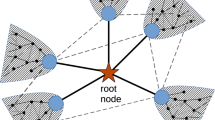Summary
The paper gives an overview of network models for representing proximity data by means of the minimum-path-length distance of connected and weighted graphs. Methods now exist for scaling metric as well as nonmetric data, symmetric and nonsym-metric proximity measures, two-way and three-way data.
Access this chapter
Tax calculation will be finalised at checkout
Purchases are for personal use only
Preview
Unable to display preview. Download preview PDF.
Similar content being viewed by others
References
ANDERSON, J. R. (1983): The architecture of cognition. Harvard University Press, Cambridge.
ARABIE, P., and CARROLL, J. D. (1980): MAPCLUS: A mathematical programming approach to fitting the ADCLUS model. Psychometrika, 45, 211–235.
BALES, R.F. (1970): Personality and interpersonal behavior. Holt, Rinehart, and Winston, New York.
CARROLL, J.D. (1976): Spatial, non-spatial and hybrid models for scaling. Psychometrika, 41, 439–463.
CARROLL, J. D., CLARK, L. A., and DESARBO, W. S. (1984): The representation of three-way proximities data by single and multiple tree structure models. Journal of Classification, 1, 25–74.
CARROLL, J. D., and PRUZANSKY, S. (1980): Discrete and hybrid scaling models. In E. D. Lantermann and H. Feger (eds.): Similarity and Choice. Hans Huber, Bern.
COLLINS, A. M., and LOFTUS, E. F. (1975): A spreading-activation theory of semantic processing. Psychological Review, 82, 407–428.
COLLINS, A. M., and QUILLIAN, M. R. (1969): Retrieval time from semantic memory. Journal of Verbal Learning and Verbal Behavior, 8, 240–247.
CORTER, J.E., and TVERSKY, A. (1986): Extended similarity trees. Psychometrika, 51, 429–452.
CUNNINGHAM, J.P. (1978): Free trees and bidirectional trees as representations of psychological distance. Journal of Mathematical Psychology, 17, 165–188.
CUNNINGHAM, J. P., and SHEPARD, R. N. (1974): Monotone mapping of similarities into a general metric space. Journal of Mathematical Psychology, 11, 335–363.
DE SOETE, G. (1983): A least squares algorithm for fitting additive trees to proximity data. Psychometrika, 48, 621–626.
FEGER, H., and BIEN, W. (1982): Network Unfolding. Social Networks, 4, 257–283.
FEGER, H., and DROGE, U. (1984): Ordinale Netzwerkskalierung [Ordinal network scaling]. Kölner Zeitschrift für Soziologie und Sozialpsychologie, 3, 417–23.
HAGE, P and HARARY, F. (1983): Structural models in anthropology. Cambridge University Press, Cambridge.
HUTCHINSON, J. W. (1989): Netscal: A network scaling algorithm for nonsymmetric proximity data. Psychometrika, 54, 25–52.
JOHNSON, S.C. (1967): Hierarchical clustering schemes. Psychometrika, 32, 241–254.
KLAUER, K. C. (1989): Ordinal network representation: Representing proximities by graphs. Psychometrika, 54, 737–750.
KLAUER, K. C., and CARROLL, J. D. (1989): A mathematical programming approach to fitting general graphs. Journal of Classification, 6, 247–270.
KLAUER, K. C., and CARROLL, J. D. (1991): A comparison of two approaches to fitting directed graphs to nonsymmetric proximity measures. Journal of Classification, 8, 251–268.
KLAUER, K. C., and CARROLL, J. D. (1993a): Network models for scaling proximities. Manuscript submitted for publication.
KLAUER, K. C., and CARROLL, J. D. (1993b): Assessing cognitive structure by means of network models. Manuscript submitted for publication.
KRANTZ, D. H., LUCE, R. D., SUPPES, P., and TVERSKY, A. (1971): Foundations of measurement (Vol. 1). Academic Press, New York.
ORTH, B. (1988): Representing similarities by distance graphs: Monotonie network analysis (MONA): In H.H. Bock (ed.): Classification and related methods of data analysis. Proceedings of the First Conference of the International Federation of Classification Societies (IFCS). North-Holland, Amsterdam.
POWELL, M. J. (1977): Restart Procedures for the Conjugate Gradient Method. Mathematical Programming, 12, 241–254.
RYAN, D. M. (1974): Penalty and Barrier Functions. In P. E. Gill and W. Murray (eds.): Numerical Methods for Constrained Optimization. Academic Press, New York.
SATTATH, S., and TVERSKY, A. (1977): Additive similarity trees. Psychometrika, 42, 319–844.
SCHVANEVELDT, R. W., DEARHOLT, D. W., and DURSO, F. T. (1988): Graph theoretic foundations of pathfinder networks. Computational Mathematical Applications, 15, 337–345.
SHEPARD, R. N., and ARABIE, P. (1979): Additive clustering: representation of similarities as combinations of discrete overlapping properties. Psychological Review, 86, 87–123.
TVERSKY, A. (1977): Features of similarity. Psychological Review, 84, 327–352.
TVERSKY, A., and GATI, I. (1982): Similarity, separability, and the triangle inequality. Psychological Review, 89, 123–154
Author information
Authors and Affiliations
Editor information
Editors and Affiliations
Rights and permissions
Copyright information
© 1994 Springer-Verlag Berlin Heidelberg
About this paper
Cite this paper
Klauer, K.C. (1994). Representing proximities by network models. In: Diday, E., Lechevallier, Y., Schader, M., Bertrand, P., Burtschy, B. (eds) New Approaches in Classification and Data Analysis. Studies in Classification, Data Analysis, and Knowledge Organization. Springer, Berlin, Heidelberg. https://doi.org/10.1007/978-3-642-51175-2_57
Download citation
DOI: https://doi.org/10.1007/978-3-642-51175-2_57
Publisher Name: Springer, Berlin, Heidelberg
Print ISBN: 978-3-540-58425-4
Online ISBN: 978-3-642-51175-2
eBook Packages: Springer Book Archive




